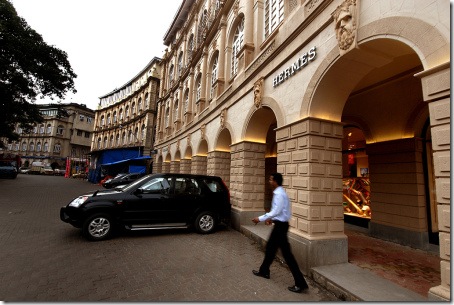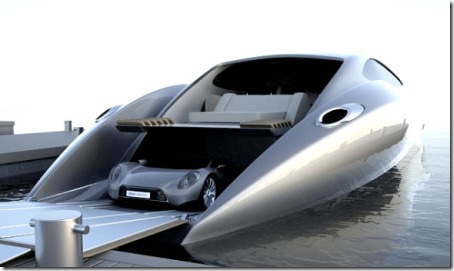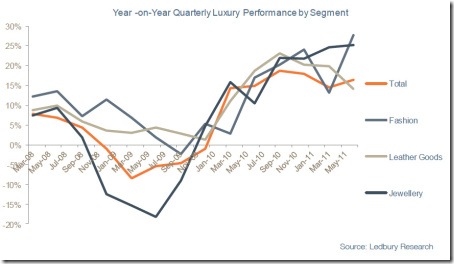
IWC’s first U.S. flagship on Madison Avenue, New York City
The Latest openings from Armani Casa, Vacheron Constantin, Roger Vivier, IWC and Jimmy Choo, in Miami, Beijing, Costa Mesta, Milan, New York & Hong Kong
Cautious whispers of a slowdown in China have rippled through the luxury industry, despite the stellar performance of luxury goods in 2012. Ledbury Research recently confirmed the increasingly wary attitudes of luxury brand CEO’s, and pointed out that while sales have increased, in many cases market share has declined.
CLSA Asia-Pacific Markets explicitly disagrees, saying Chinese consumers will continue to purchase watches, handbags, jewellery and expensive clothes. “Wealthy individuals won’t slow down their spending,” remarked CLSA analyst Aaron Fischer to the Wall Street Journal. Barring a terrorist attack, pandemic or corruption crackdown, China will continue to lead the boom in luxury goods for years to come, according to the firm’s research.
And if brick-and-mortar store openings are anything to go buy, the luxury industry still believes in the promise of China. Vacheron Constantin this month opened its third boutique in Beijing alone, as Michael Kors launched in the city’s Shin Kong Place shopping mall and Roberto Cavalli in the Peninsula Hotel. Zegna moved into tier-2 city Shenyang, as Lancel launched a new concept store in Shanghai.

Armani Casa, Miami
Armani Casa has moved into Miami’s new design district, with a 340sqm space at 10 NE 39th Street. It is the first Armani Casa store in Miami and the third in the United States. The store will house a range of furniture decor, tableware, decorative accessories, fabrics, ornaments, lighting and bathroom and kitchen products, as well as offering the brands “made to measure” interior design service.
Website: armanicasa.com
Source: WWD

Dior Homme, New York
Dior Homme has launched a pop-up space in New York’s SoHo, whilst its 57th Street undergoes renovation. The Greene Street location features ready-to-wear, footwear, eyewear, leather goods, watches, jewellery and fragrance. Creative Director Kris Van Assche has selected a piece by Robert Montgomery to display in the boutique.
Website: dior.com/homme
Source: Fashion Windows

Jimmy Choo, Hong Kong
Jimmy Choo has unveiled its first dual gender store, after expanding and renovating its boutique in Hong Kong’s Elements mall. The storefront features side-by-side entrances for women and men’s, each with its own dedicated shopping environment. The reimagined store is the first retail opening managed wholly by Jimmy Choo Hong Kong Limited, the venture created following the acquisition of the shareholding from joint venture partner Bluebell.
Website: jimmychoo.com
Source: Choo Connection

IWC, New York
IWC Schaffhausen has opened its first US flagship in New York City at 535 Madison Avenue. The NYC store is the first of its kind, presenting the company’s watch families – Aquatimer, Pilot’s Watches, Portofino, Ingenieur, Da Vinci, and Portuguese – in themed settings that reflect their individual character.
Website & Source: iwc.com

Lancel, Shanghai
Lancel has launched a concept store in Shanghai, designed by Christopher Pillot, who dressed the Champs-Elysees maison. The boutique features a handcrafted Murano glass chandelier and stained-glass panels, hand-painted by French artist Caroline Pregermain. Elsewhere oak flooring, brushed metals, LED lighting and vegetal furniture leathers house the brand’s accessories.
Website: lancel.com
Source: Luxury Insider

Lamborghini, Moscow
Lamborghini has contracted with the Burevestnik Group, a luxury automobile and yacht retailer located in Moscow, to become Lamborghini’s first official dealership. A temporary sales operation has been launched in the Crocus City Mall whilst the group finalises construction of a Moscow showroom. The completed dealership will house sales, service and accessory sales for the complete Lamborghini product line-up. (Newport Beach dealership pictured)
Website: lamborghini.com
Source: Motor Authority

Max Mara, Bucharest
Max Mara has launched a flagship store in Bucharest, which houses the Max Mara line alongside SportMax. The brand formerly operated a small store on Calea Victoriei in partnership with Alsa Group, but this new launch makes its presence in Romania one of its largest in Eastern Europe. (Paris boutique pictured)
Website: maxmara.com
Source: CPP Luxury

Michael Kors, Beijing
Michael Kors has opened his first store in Beijing and its largest in China, located in the Shin Kong Place shopping mall. The 225sqm store retails accessories and ready-to-wear from both the main and diffusion lines and features a large format video screen showing the designer’s runway shows.
Website: michaelkors.com
Source: WWD

Odin, New York
Niche perfume brand Odin New York has opened its first pop-up shop in collaboration with Snarkitecture. The pop up shop will remain open for six weeks, and will include all six of Odin’s unisex and home fragrances. The aim of the boutique is to showcase the product design by inverting the darkness of the packaging resulting in a bright, clean space.
Website: odinedt.com
Source: Bois de Jasmine

Prada, Porto Cervo
Opening its second store in the Italian holiday destination of Porto Cervo, Prada has inaugurated a 95sqm space dedicated to menswear and accessories on La Passeggiata, the town’s luxury shopping street.
Website: prada.com
Source: CPP Luxury

Roberto Cavalli, Beijing
Italian fashion designer Roberto Cavalli has opened the first phase of his debut store in China, within the arcade of the Peninsula Hotel, Beijing. The 300sqm space houses women and men’s ready-to-wear, as well as accessories, eyewear, perfumes, timewear and kidswear collections.
Website: robertocavalli.com
Source: Fashion United

Roger Vivier, Costa Mesa
Roger Vivier has opened its third U.S. boutique, and its first in California, within the South Coast Plaza luxury mall in Costa Mesa. The 92sqm space features the brand’s seasonal footwear and accessories collections, as well as the limited-edition Rendez-Vous line for traveling.
Website: rogervivier.com
Source: WWD

Salvatore Ferragamo, New York City
Salvatore Ferragamo’s largest boutique – its Fifth Avenue flagship – has reopened following 13th weeks of renovation. The 1,900sqm space features womenswear, menswear, accessories, shoes, and also the recently launched fine jewellery collection. The brand also used the occasion to debut the Travel Luggage Collection, set to launch this summer.
Website: ferragamo.com
Source: Style Rumor

Shanghai Tang, Hong Kong
Shanghai Tang has launched a three-storey Mansion in Hong Kong, celebrating modern elegance and fashion through colours, exquisite fabrics, unique designs and prints. Womenswear occupies space on the ground and first floors, featuring a curved ceiling, a peony brass-inlay on the wooden flooring, fan-patterned screens and semi-circular seating.
Evoking a discreet gentleman’s club in warm hues, the calm, masculine Men’s wear floor offers ample leather seating, as well as an embossed dragon, a Chinese symbol of power.
Website & Source: shanghaitang.com

Sotheby’s, Hong Kong
Sotheby’s is soon to open a 1,400sqm permanent exhibition space in Hong Kong, and will celebrate with a string of exhibitions running through the end of May. The gallery will occupy the entire fifth floor of One Pacific Place, the massive space will become a sort of HQ for the global auction house to expand its presence in Asia beyond its current biannual auction series in April and October.
Website: sothebys.com
Source: Jing Daily

Vacheron Constantin, Beijing
Vacheron Constatin has unveiled its third flagship Beijing, on the ground floor of Beijing Macau Center, bringing the total number of stores worldwide to 30. The opening also coincided with the arrival of three special edition watches in Beijing and at the store, including the newly launched Patrimony Traditionnelle 14-Day Tourbillon, Métiers d’Art Kalla Haute Couture à Pampilles and the Patrimony Traditionnelle Calibre 2253.
Website: vacheron-constantin.com
Source: Luxury Insider

Zegna, Shenyang
Ermenegildo Zegna recently celebrated the opening of its fourth China flagship, in the north-eastern luxury hotspot Shenyang. The 505sqm space within Shenyang’s MixC mall has been designed by architect Peter Marino, divided into three sections for each of Zegna’s brands: Ermenegildo Zegna suits and accessories, Z Zegna, and Z Sport.
Website: zegna.com
Source: Jing Daily
For more in the series of The Latest Boutiques, please see our most recent editions as follows:
– The Latest Boutiques: Chanel, Tom Ford & Valentino
– The Latest Boutiques: Céline, Chaumet & Elie Saab
– The Latest Boutiques, Burberry, Bally & Boucheron
© Luxury Society, The Latest Boutiques: Sotheby’s, Shanghai Tang & Salvatore Ferragamo, 09 May 2012, by Sophie Doran.
Live the life!






















